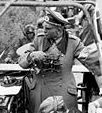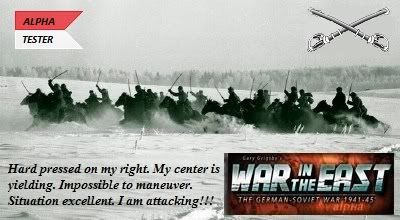morvael
Posts: 11762
Joined: 9/8/2006
From: Poland
Status: offline

|
Food for thought from game manual for V for Victory (WitE of the 1990's - wow it's so many years from now):
quote:
Field Fortifications
There are two types of field fortifications that units may construct during the game. Both of them benefit defending units only; there is no advantage to attacking out of a hex that contains a field fortification. A unit that is "dug in" has foxholes, weapons pits, pre–registered targets, pre–planned fields of fire, and a generally planned, prepared and organized defense. A "fortification" represents all these things plus minefields, some barbed wire, the beginnings of a trench system, and a few simple log and earth bunkers.
Each field fortification appears on the map as the uppermost "unit" in its hex. (These are really just markers, not units.) The "size" of a field fortification is indicated by the number at the bottom of the marker, and that size is the number of companies that may gain full benefit from being in the same hex with it. Each battalion equals 3 companies for this purpose, so a size 9 field fortification can "contain" 9 companies (or 3 battalions), which is the stacking limit for most of the hexes on the map.
Field fortifications may be enlarged by having the same or other units build another one in the same hex. If more than one unit is constructing a field fortification in a hex at the same time, only one "building" marker is shown. Larger field fortifications have no additional effect except that more units may benefit from them.
Field fortifications may never move, and benefit only friendly units in the same hex with them. Once the field fortification is completed, the unit that built it is free to conduct other activities and/or move away, and other friendly units are free to move in and benefit from it. However, a field fortification is automatically removed from the map at the end of any turn that there are no friendly units in the same hex with it.
Most defensive positions are actually directional in nature; i.e., they face a particular direction and provide maximum benefit to the defender only if he is attacked from that direction. Each field fortification therefore represents a planned and prepared defensive line which, in reality, would have a significant effect only if attacked from the "front." Although they are realistic, directional combat effects are typically found only in tactical– level games, and would be a considerable added complication in an operational–level games such as the V for Victory™ series. We considered expanding the game system to include directionality and decided that, at this scale, it is not worth the trouble; very nearly the same result can be achieved in a much simpler way. V for Victory™ games assume that, when initially built, a field fortification faces the enemy, or at least the direction the enemy is most likely to approach from. As long as the position is continuously occupied, that directionality is preserved, and the probability that the field fortification will be beneficial remains high. However, if a position is ever captured or abandoned, its original directionality is presumed to be lost, and whatever remains of the field fortification is assumed to be facing the wrong way, or located in the wrong place within the hex, to be of much use to later occupants of the hex. This argument applies especially to captured positions.
Digging In
All units may dig in except those that are adjacent to an enemy unit, or those that are located in a located in a swamp, bunker, beach bunker, or fortress hex. It normally requires two turns to dig in. To begin, select the unit and press the letter "F" on the keyboard. (Or, you can open the Command Box for that unit, make sure the unit is assigned one of the three "defend" options, click on the "dig in" symbol, and then close the Command Box.) This causes a "digging in" marker to appear as the top unit in that hex on the map. To finish digging in, "dig in" orders must be assigned again on the next game–turn; as a convenience, the game automatically does that for you, so that once a unit begins to dig in, it continues to do so until you change its orders. If you assign orders other than "dig in" on the next turn, the process is either interrupted or canceled. If the unit moves out of the hex, the process is canceled, and the digging in marker is removed from the map. The process is merely interrupted (and may be completed on a later turn) if the unit is attacked by artillery/naval/air (with no enemy units adjacent), participates in combat as an attacker or defender without leaving the hex, if the unit remains inactive in order to recover from fatigue or disruption or to receive replacements, or if the unit is an artillery unit and conducts a fire mission. If an enemy unit moves adjacent to a unit in the process of digging in, the process is canceled and the "digging in" marker is removed from the map.
When dug in units are defending in a hex that contains a dug in marker large enough for all of them, it multiplies their defense strength by 1.5, their antitank strength by 1.25, increases their morale by 1, and halves the strength of incoming artillery/naval/air attacks. If the dug in marker is not large enough to contain all the units in the hex, it multiplies their defense strength by 1 + (0.5 x (marker size/stack size)), it reduces the strength of incoming artillery/naval/air attacks by a proportional fraction, and it has no effect on the antitank strength or the morale of the defending units.
The advantages of being dug in do not apply to units that are conducting probes, assaults, all–out assaults, or any type of movement.
In Velikiye Luki, during hard freeze and deep snow ground conditions, non–engineer units may dig in only in village and city hexes. Engineer units may still dig in when they are in clear terrain or forest hexes, but this takes twice as long as normal (i.e., four game–turns). Both engineer and non–engineer units may dig in when they are in lake hexes only during deep snow conditions (when the lake becomes clear terrain for all purposes).
Fortifications
Fortifications are constructed in the same manner as digging in, except that the first fortification marker in a hex may be built only by an engineer unit, and constructing the first fortification in a hex normally requires four turns. Like digging in, a fortification may not be built or enlarged in a bunker hex, or in a hex that is adjacent to an enemy unit. Unlike digging in, a fortification may be built or enlarged in a swamp hex, but this takes twice as long as normal (i.e., eight game–turns).
When units are defending in a hex that contains a fortification large enough for all of them, it multiplies their defense strength by 2, their antitank strength by 1.5, increases their morale by 2, and halves the strength of incoming artillery/naval/air attacks. If a fortification is not large enough to contain all the units in a hex, it multiplies their defense strength by 1 + (fortification size/stack size), their antitank strength by 1 + (0.5 x (fortification size/stack size)), it halves the strength of incoming artillery and air attacks, and it raises the morale of the defending units by 1.
Like being dug in, these advantages do not apply to units that are conducting probes, assaults, or any type of movement.
In Velikiye Luki, during hard freeze ground conditions, engineer units may still construct fortifications in all types of terrain except lakes, but this takes twice as long as normal (i.e., eight lake hexes during hard freeze conditions, they may be constructed on lake hexes during deep snow (when the lake becomes clear terrain for all purposes). This also requires eight game–turns.
Note that in Velikiye Luki, for the purpose of constructing field fortifications, construction battalions are engineer units.
Digging In and Fortifying in the Same Hex
A hex may not contain a completed dug in marker if it also contains a completed fortification, and vice versa. Both may be under construction at the same time (in which case the fortification is the one that appears), and either may be under construction in a hex that contains a completed one of the other (in which case whichever one is completed is the one that appears).
When a fortification is completed in a hex that already contains a completed dug in marker, the size of the newly–completed fortification is immediately increased by one–half of the size of the dug in marker (fractions rounded down), and the dug in marker is removed. For example, if a hex contains a completed dug in marker of size "3," and a building fortification of size "1," when the fortification is completed, it becomes size "2," and the dug in marker is removed.
Units may be assigned to dig in a hex that already contains a completed fortification. However, in this case the dug in marker never appears on the map; when the units are finished digging in, the already–complete fortification marker is enlarged instead. The amount that the fortification is enlarged by depends on the size of the unit that is digging in; a company–sized unit enlarges the size of the fortification by 1, and a battalion–sized unit enlarges the size of the fortification by 2. For example, if a hex contains a completed fortification marker of size 1, and a battalion–sized unit digs in the hex, when it is finished digging in, the fortification marker is enlarged from size 1 to size 3. This process may be repeated to enlarge the fortification to size 5, and so on.
Please bear in mind that even though authors of that game consider V4V as operational game (as WitE authors say about their game) the scale there was 1km per hex, 4 hours per turn and units (counters) were of battalion and company level, so a division would consist of 10-15 counters (Soviet divisions were smaller, as one rifle regiment was one counter). So they made a full length game about Velikiye Luki, whereas in WitE it's just a micro-scenario :)
However there are interesting ideas here about fortifications. First of all, fortifications besides their level, have size. So it would take 4 turns per level x 15 levels = 60 turns for a company of engineers to build a maximum size of field fortifications in a city hex - that's 10 days - that's counted without fatigue - they would tire after a day or two and building would take event longer that that. And that would be only for an area 1km in diameter. Of course aided by 3 battalions of infantry they would complete the work much faster. Anyway, it was good to have size of fortifications - you wanted to have large fortification and fast - you had to put a lot of men with shovels there.
Second great idea was separating digging in from field fortifications that only engineer units could start. Regular units without engineer help could only dig in.
Third great idea was that preparing trenches requires no bullets whizzing over your back, so it's impossible to improve them once you are in contact with the enemy.
Fourth great idea was that there were 2 more "levels" of fortifications: bunker terrain and fortress terrain and they were not buildable which was ok, considering the length of scenarios in V4V - at most 3 months of time. They were much better than digging in and field fortifications but there were only so many as the designers allowed in proper places.
Fifth great idea was that fortifications disappeared after you left them - a good balance between details and simplicity - this represented that fortifications are directional in nature and once a fighting position was left, they would be of little use should a frontline reach that hex again.
Interesting are also those notes that say about difficulty of digging in in snow conditions - regular units could do that only in villages and cities.
WitE has of course different scale which changes many aspects, however some could be modeled. Size - this I think is represented by the fact that 3 units would dig faster than one having more "digging factors". Higher level fortifications should require more engineer elements involved otherwise they would be impossible to complete or very slow (so a unit with just a company of engineers should not expect to build higher levels of forts - for really high level you should attach some support engineer units). Building should be very slow when in contact with the enemy of course (it is, but is this really slow or just a little bit slower - I don't know). Units without engineers should be able to build only level 1 fortifications (dig in from V4V), units with engineers should be able to build level 2 (field fortification from V4V), levels 3-4 (bunkers from V4V) should be only possible with an AP cost and some high wait times, and not when in contact with enemy), level 5 should be restricted to pre-war really strong fortifications and not buildable. Once left a fortification should loose at least 1 full level per turn, except fortifications of level 5. Of course that's my interpretation of rules for V4V translated into WitE scale. Yours may vary, I just wanted to show how it was done in another good game, that had a bit different scale though.
|
 Printable Version
Printable Version















 New Messages
New Messages No New Messages
No New Messages Hot Topic w/ New Messages
Hot Topic w/ New Messages Hot Topic w/o New Messages
Hot Topic w/o New Messages Locked w/ New Messages
Locked w/ New Messages Locked w/o New Messages
Locked w/o New Messages Post New Thread
Post New Thread